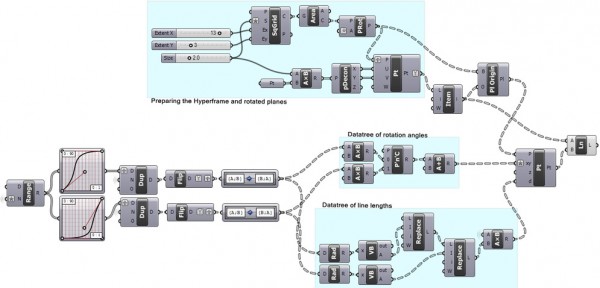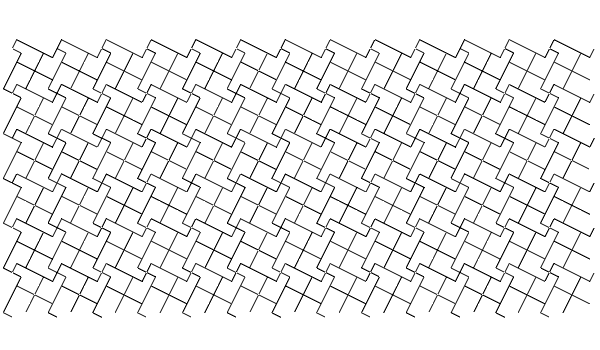Crossover
by Tuğrul Yazar | August 20, 2013 13:52
Crossover is a single-axis, line-based deformation algorithm, constructed on a regular quadrangular hyper frame, designed by Richard Lane at the Basic Design studio of William Huff in 1963. It presents two apparently different parquet deformation[1] sequences linked together. Thus, the designer created a transition between the borders and inner cross-shapes gradually. This transition is visually smooth and interesting because of the component shift in the middle. It actually does not include polygonal components as seen at first sight but works with a sequence of point and line orientations instead. This liberation from the traditional understanding of polygonal component logic gives designers to manipulate and de-construct the system easily in order to re-construct again in a different fashion. This is why I tried to implement Crossover in Grasshopper. Below is the original hand drawing of the pattern.

Crossover with Grasshopper
In the first experiment, I tried to put a polygonal component and manipulate it eventually, creating a horrible complexity. Then I started to work with points and lines only. The logic under this was to organize point and angle directions in proper data trees. Then, create the whole pattern with a single line component in the end. So, as Grasshopper does not include a built-in extension component for lines using multiple boundaries (like Rhino, Rhinoscript, or even AutoCAD easily does), I added a simple cluster to overcome these extensions using right-angle trigonometry. Here is the Grasshopper definition if you want to try this:
 [3]
[3]As my intention was to develop a duplicate of this hand-made tessellation of the 60s, I added lots of parameter lists and constraints to achieve that. They are mostly “internalized” within parameter inputs. You can extract these data lists to change them. It is possible to play with those parameters and constraints to study different patterns.

A Note
Douglas Hofstadter mentions this pattern in a rhapsodic way;
…This is a simple example of the ubiquitous visual phenomenon called regrouping, in which the boundary line of the unit cell shifts so that structures jump out at the eye that before were completely submerged and invisible -while conversely, of course, structures that a moment ago were totally obvious have now become invisible, having been split into separate conceptual pieces by the act of regrouping, or shift of perceptual boundaries. It is both a perceptual and conceptual phenomenon, a delight to that subtlemixture of eye and mind that is most sensitive to pattern. For another example of regrouping, take a look at “Crossover”, also executed at Carnegie-Mellon in 1963 by Richard Lane. Something really amazinghappens in the middle, but I won’t tell you what. Just find it yourself by careful looking…
Hofstadter, D., (1983), Parquet Deformations: A Subtle Intricate Art Form. Chapter 10, in Metamagical Themas Questing for the Essence of Mind and Pattern. New York: Basic Books, p.191-212.
- parquet deformation: http://www.tess-elation.co.uk/parquet-deformations
- Download: https://www.designcoding.net/decoder/wp-content/uploads/2013/08/2013_08_20-crossover.ghx
- [Image]: https://www.designcoding.net/decoder/wp-content/uploads/2013/08/2013_08_20-crossover-def.jpg
Source URL: https://www.designcoding.net/crossover/